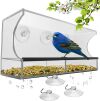
What’s This Post About?
Blue Jay is a large songbird with a striking combination of blue, white, and black plumage with a dappled pattern following its tail and feathers and a small sharp beak.
These birds are found in scattered forests and are frequent guests in parks of suburban and residential areas.
Both the male and female birds are easy to spot as there is no evident difference in their appearance.
They are usually easily recognizable, especially if you’re strolling in a park or maybe the outskirts of a suburban region.
Blue jays aren’t rare. Their population seems to have stabilized over the past few years. They inhabit mixed forests throughout the central and northern areas of the United States and the Southern Canadian Pacific Coast. They have extended northwestwards recently.

Are Blue Jays Migratory Birds?

Hundreds and thousands of blue jays migrate in flocks together across the great lakes of Atlantic coasts, but their migration remains a mystery.
They are present throughout winters in the regions they inhabit but are out of sight as other seasons set in. This is mainly because it’s their nesting season, and they don’t want to blow their cover by being excessively chirpy.
Young jays are more likely to migrate than adults. Some of them scatter far and wide towards the south and stay the following winter and then migrate again to the southern regions.
No one has quite figured out the reason behind their unconventional movement pattern.
Fun Fact
Some blue jays you see in your backyard during the wintertime may not be the same as those you see in the summers. Blue jays do migrate in some cases while some do not, opting to spend the winter on their breeding grounds given their territorial nature.
State By State Comparison Of Blue Jays

The Northeast
Since blue jays are scattered across the mixed forests and residential parks of the eastern and central areas of the United States, they can also be found in parks and suburban areas and are frequent guests of backyard bird feeders.
Blue Jays populate the woodlands, suburbs, and residential areas of north Maryland, Delaware, New Jersey, Pennsylvania, Connecticut, Rhode Island, New York, Massachusetts, Vermont, New Hampshire, and Maine.
These birds are a common sight in the aforementioned states mainly because they’re native to those regions.
So, it’s safe to say that if you’re living in these areas, do expect to see them frequent your local parks and the feeders in your backyard.
The Southeast
They are found in Alabama, Florida, Georgia, Kentucky, Maryland, Mississippi, North Carolina, South Carolina, Tennessee, Virginia, and West Virginia.
These states see them all year round mainly because of their territorial nature, which compels them to remain permanent residents of their range.
Many kinds of birds migrate to warmer climates during winter.
Blue jays, however, are least affected by the change of climate, and because of this, they remain in the region they inhabit during the summers, even when the temperature drops below zero.

The Midwest
Blue jays nest across the rocky mountains of the western region in the United States, partially covering areas of Nebraska, North Dakota, Ohio, South Dakota, and Wisconsin.
But they’re mainly concentrated in Missouri, Kansas, Illinois, Indiana, Iowa, and Michigan. Since these states are wide stretches of grass-covered fields, blue jays do not prefer these areas.
This is because these areas do not provide them with the necessary shelter from predators that they might need to nest and roam about.
But you can still have these stunning birds in your backyard if you put in the right amount of effort.
The Southwest
Blue jays scarcely inhabit the regions of Arizona, New Mexico, and adjacent portions of California, Colorado, Nevada, Oklahoma, Texas, and Utah.
This is because the landscape features of these areas include canyons, mountains, plateaus, and desert lands with little to no vegetation.
So, if you’re a bird watcher residing in one of these areas, you’re going to have to put in extra effort to attract these birds to your backyards since they’re particularly rare in the Southwestern region of the US.

Do Blue Jays Live A Long Life?
Bird-watching enthusiasts often find themselves getting curious about how long these beautiful blue jays live.
According to the North American Breeding Bird Survey, their population decreased by 28% between 1966 and 2015, 87% of which live in the U.S, and the rest, 13%, live in Canada.
Fun Fact
The Blue Jays represent the Toronto Blue Jays major league baseball team and numerous other schools and universities in Canada!
Blue jays have considerably longer lives in captivity, with the oldest blue jay documented reaching 26. They rarely live in the wild for 5-7 years, and the most common cause of death is due to predator attacks.
How Do You Tell The Difference Between A Blue Jay And A Bluebird?

The unique crests on the heads of blue jays seem to be the only visual distinction between these species. Even inexperienced birders can identify this.
We’ll go over how to tell these birds apart in more detail in the following categories.
| BLUE BIRD | BLUE JAY | |
|---|---|---|
| CALLS AND SOUNDS | Low pitched warbling, soft notes, stuttered whistles, a string of notes. | Loud jeers, clicks, whistles, gurgles, hawk mimic, liquid notes. |
| SIZE | 6.5-8 inches | 9.8-11.8 inches |
| PATTERN | The pattern on their plumage doesn’t stand out. It mostly has soft wing and tail feathers. | A dabble-like pattern on both its wings and tail. |
| WING SHAPE | Long and wide | Long and wide |
| COLOR | The chin, chest, throat, and flanks are all a rusty brown color. The head, wings, back, and tail are all bright blue. | The head is a bluish-purple color, with a white face, throat, and chin, a black necklace, and vivid blue wings and tail. |
| BEHAVIOUR | Territorial, Conservative followers frequently hang low to look for insects. | Attackers, “bully birds”, territorial, aggressive, intelligent |
| HABITAT | Southwestern, Central, and Northern United States | Eastern North America, Southern Canada |
Keep The Predators Away

Any birdwatcher needs to understand the possible threats posed by predators who may hunt these birds down.
There are several animals, birds, and reptiles that consume them to survive. But how can you keep these blue-colored residents out of misfortune?
Warning
Keep an eye out for potential predators roaming about your territory. Blue jays are attacked and devoured by a wide range of predators, including bigger birds, mammals, and reptiles.
The solution is simple. Before installing your feeders, plan on where you want them.
Place the feeders away from dense shrubs, high walls, roofs, windows, trees, and anything else that predators could use to target these precious birds.
Instead, jack up these feeders and set them 10-12 feet above the ground, away from thick plants, where many predators often lurk.
This allows birds to keep an eye out for predators hidden in trees or plants. It also creates a haven close enough for birds to take cover quickly if they sense any danger.
Why Are Blue Jays So Noisy?
Blue jays are louder in fall than in spring or summer!

Many avid bird watchers have noticed that Blue Jays, who are usually quiet in the spring and summer, become noticeably louder in the fall.
Jays are more cautious in the spring and early summer when they are nesting. But when they’re scavenging for food in the fall and hawks are present more, they use their sounds to express a range of information and warnings.
Fun Fact
It is common to hear a blue jay mimic hawks. They do this because mimicry serves as a warning to other jays about any lurking hawks.
Blue jays defend each other by being loud as they move about neighboring yards in family groups of up to a half-dozen searching for food. As lookouts, one or two jays perch on a tree.
If the lookouts spy a cat, they’ll scream jeer calls, which will explode in jeers from the entire family.
A Rare White Blue Jay - Do They Exist?
This white blue jay is also called “leucistic jay,” which has a rare genetic condition that removes all pigment, preventing melanin production, which results in muted colors on the bird’s plumage.
Pure white jays are incredibly difficult to spot.
A leucistic blue jay might even be rarer than that of other species. Only 1% of these stunning species are believed to be affected by this disorder.
Coloring protects the bird, and with white blue jay missing most of it, they stand out, which makes them much more vulnerable to predators.
Since spotting a white blue jay is extremely rare, you won’t come across one that easily. But if you spot birds in your backyard long enough, you’ll eventually see one with mostly white or all-white feathers.
How To Differentiate Between A Male And Female Blue Jay?

The male of most wild bird species stands out and has more colorful and vivid markings than the female. With the blue jays, this is not the case.
Female blue jays are rather complex to spot from the males, given the resemblances in both sexes. So how do you tell the difference between the two blue sexes of blue jays?
The best way to tell the sexes apart is to observe their courting and nesting behavior.
While building trial nests, both the male and female blue jays will share responsibility. The female, on the other hand, does the majority of the actual nest-building.
How Can You Attract Blue Jays To Your Backyard?

A tray or platform feeder is the most common type of feeder used to attract blue jays. Hanging feeders that swing or wobble should be avoided since they provide little stability for blue jays.
Instead, use ground or pole-mounted feeders.
Fun Fact
Blue Jays are among the most intelligent birds you'll see at your feeder. They have intellectual qualities that are similar to those of humans.
Another thing that you can do is gather their favorite nuts and acorns and add them to your feeders.
In addition to seeds and nuts, they prefer to feed on frogs, insects, and fruits as well. Make sure your backyard has lots of bushes and trees to provide these birds with the right treats.
To invite jays to your backyard, you could use an appropriate bird feeder. If you’re looking for a feeder that is suitable for attracting blue jays to your backyard, then you can explore the window bird feeder.
Window Bird Feeder with Strong Suction Cups and Seed Tray
It makes bird watching fun and easy from the comfort of your own home while relaxing in your favorite spot
Keep Reading!
To sum it all up, blue jays are only a rarity in the regions they’re not native to; besides, their population seems to have stabilized over the past few years, which is a good sign.
If you want Blue jays to visit your backyard, then you must know that they prefer mature trees, specifically oak trees, to nest and breed in, so make sure you’ve got a few planted in your backyard.
If you are a blue jay enthusiast, here’s a post you can read to see which birds look like blue jays.
Bird That Looks Like A Blue Jay? This Is The One
The Blue Jay belongs to the Corvidae family. Often several birds are misinterpreted as Blue Jays because of multiple reasons. Read to find out more.

By David A. Swanson
Bird Watching USA
My name is David and I'm the the founder of Bird Watching USA! I started Bird Watching with My father-in-law many years ago, and I've become an addict to watching these beautiful creatures. I've learnt so much over about bird watching over the years that I want to share with the world everything I know about them!

David A. Swanson
Bird Watching USA
My name is David and I'm the the founder of Bird Watching USA! I started Bird Watching with My father-in-law many years ago, and I've become an addict to watching these beautiful creatures. I've learnt so much over about bird watching over the years that I want to share with the world everything I know about them!








